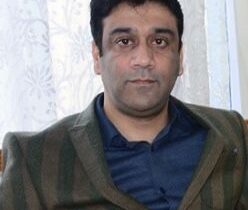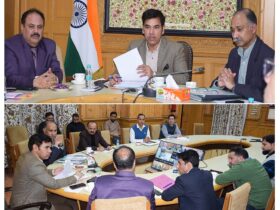Writes Dr. Manzoor Ahmed yetoo
Healthcare is one of the fastest growing sectors, both in India andabroad. People are increasingly becoming health conscious andare in lookout for quality healthcare systems that would providesolutions in a holistic way. There has been an increasing numberof ageing population, putting additional burden on the already overburdenednational healthcare systems in developed countries. Increase in cost of health insurance isadding the number of uninsured population in these countriesAccording to a studyby PriceWaterHouse-Coopers, the cost of premium for health insurance during theperiod 2004-2005, has gone up by 8.8% in USA. Cost increase isbeing attributed to general inflation, increase in cost of healthcareservices (cost of updated technology, broader access plans) andincrease in utilization (aging, lifestyle, new treatments). Such ascenario provides opportunities for Indian healthcare sector. Many analysts have predicted that healthcare tourism will be oneof the next big opportunities for India. Such predictions are on the grounds that India is one of the countries with highly skilledprofessionals and with advanced healthcare solutions. It may bementioned that Indian doctors have been serving in developedcountries such as USA, UK and Canada and have gained high reputation.
In addition, India’s popularity in the international arenais increasing with the valence of traditional wellness systems, especially Ayurveda and Yoga. It is estimated that a large numberof tourists have visited India to practice the wisdom of Indianwellness systems.Multi-language skill, which is one of the prominent interfaces whileavailing healthcare as also the tourism services abroad, is anotheradvantage for India and J&K . In addition to proficiency in English, Indiansare proficient in speaking Hindi, Urdu, Bangla, Arabic, Tamil, whichare widely spoken in neighboring countries of West Asia, Southand South East Asia.
Another reason for India& J&K emerging as a major destination forhealthcare is the low cost of treatment prevailing in India. Indianhospitals are cost effective than many developed countries suchas USA and Europe. Even when compared to other South-EastAsian countries, such as Thailand and Singapore, India scoresbetter, with the cost of procedures cheaper by around 20 percent.There are estimates that by 2008, companies in USA will bespending as much on healthcare as they made profits, forcing the scaling back or withdrawal of benefits. As precaution, some firmshave begun considering treatment for their employees in low cost
Destinations. Thus, low cost healthcare services coupled withinternationally acceptable medical practices would position Indiaas an attractive healthcare destination. Estimates show that the average success rate of cardiac surgeries in Indian hospitalscompares favorably with developed countries. The success rateof Indian physiotherapists helping patients regain their physicalfitness and prevent cardiac problems is at an average of 99.5percent, at par with leading cardiac centers around the world.
Long waiting time in several countries works in favour of growthin healthcare tourism flows towards developing nations. Countries,such as UK and Canada, that provide free healthcare services totheir citizens thus become a source for large number of healthcaretourists visiting India. Indian players could leverage quality inservices rendered alongwith low cost healthcare solutions, to attractmore number of patients from these countries into India.
At industry level, several initiatives are taken to showcase India asa healthcare destination but J and K Government needs an eye opener. First and foremost is formation of IndianHealthcare federation to voice the concerns of the industry. Indianhealthcare establishments are also working closely with otherstakeholders such as hotels, travel agents, tour operators and
airlines to offer healthcare tourism as a composite service. Whiledoing so, patient safety is being ensured through collaborativeefforts of various stakeholders. Some healthcare service providers have formed strategicalliances with leading healthcare establishments in the world.
Efforts are being made to tie-up with national healthcare systemsabroad and social / commercial insurance providers. Few of themhave also established alliances with academic and researchinstitutions abroad to update on medical technologies andpractices. Players are imparting hi-tech equipments and medicalinfrastructure such as the da Vinci Surgical System for RoboticCardiac Surgery, 64 slice CT Scan, Linear Accelerators similar toSloan Kettering, New York44. Strict blood safety and infection controlprocesses are installed. Some healthcare establishments are offering free specializedhealthcare camps as also free surgeries under the umbrella ofcorporate social responsibility. Data generated through such campsare used extensively in their research and development activities. Leading players of the industry are looking at accreditationintensively – be it from national or international accreditationagencies. Initiatives are also being taken to offer healthcareservices by way of setting up of healthcare establishments abroad.Some of them have also established their presence abroadthrough leveraged buy-outs. Interesting feature is thatestablishment of healthcare institutions abroad is also in thetraditional wellness systems, such as Ayurveda and Yoga. Indianhealthcare establishments, focusing on international tourists, havestarted providing associated value added services such asarranging accommodation, facilitating completion of traveldocumentation, travel arrangements, translation services andescort services. Such initiatives have been projecting India’sprowess in hospitality skills as also a destination for healthcare
Solutions. Government has also been supportive of the initiatives taken bythe healthcare and tourism industry to realize the potential. Thecenter and many state governments are encouraging healthcare tourism firms to participate in international fairs and promotionalprogrammes to showcase the capabilities of India. Many stategovernments have unveiled specific policy supporting healthcaretourism. State governments, such as Kerala, are leveraging their
specialization in Ayurveda and have announced customized policiesto attract healthcare tourism.
Government of India has announced two separate nationalpolicies for development of a) healthcare, and b) tourism.Government of India has formed a Task Force on Medical Tourism with the objective to suggest policy framework to project India asa healthcare destination. The Government has set up NationalAccreditation Board for Hospitals to provide accreditation to publicand private hospitals ensuring quality in healthcare services. TheGovernment has announced a policy framework for issue of MedicalVisa to ease the immigration procedures of healthcare andaccompanying tourists. Foreign Direct Investment is permitted upto100 percent for setting up of hospitals as also hotels and tourismprojects in India.
Promotion of healthcare tourism not only helps in development ofthe two major sectors, viz., healthcare and tourism, but alsoassociated services sectors. With more and more investment goinginto setting up of specialty hospitals, it is expected that the medicaldevices and equipment segment would witness considerabledevelopment. Industry estimates suggest that around one-third ofcapital expenses in setting up of super specialty hospitals go in for procurement of medical devices and equipments. The increasein automation, demand for hi-technology, computer aidedapparatus, diagnostic and medical laboratory equipments would help in attracting investment, technology transfer, and FDI in theIndian medical equipment sector.
The world healthcare industry, in order to cut down the cost,is outsourcing its research and administrative expenses. In addition,the volume pressure would mandate several health maintenanceorganizations to outsource portion of their work to low costdestinations.
Information technology is becoming a major enabling sectorfor healthcare delivery all over the world. At present, healthcareorganizations are estimated to be outsourcing around 10% their IT requirements. However, in the near future, the share of IToutsourcing is expected to increase providing opportunities for IndianIT capabilities. India has been traditionally attracting outsourcingbusiness in medical insurance claim processing and digitizing thepatient health records (medical transcription). This is being furtherstrengthened with outsourcing of high-end services such as clinicaldata analysis, biometric services and chemical engineering. India’sstrengths in IT and IT enabled services could be leveraged tosupport such knowledge processing activities.Leveraging information technology, a specialist or a super Specialist in a hospital could give advice to the patients or evenmonitor the patient’s health conditions. Similarly, medical studentscan observe conduction of operations in another location leveraginginformation technology. The concept of telemedicine would becomemore and more popular with an increasing outsourcing ofhealthcare services. In addition, the biggest beneficiary of theconcept of telemedicine would be the rural population, who has limited access to medical facilities.
Another area of opportunity is health insurance business asalso outsourcing of health insurance. Although the penetration ofhealthcare insurance is only 10% in India, Insurance Regulatoryand Development Authority views the health insurance is one ofthe fastest growing portfolios of general insurance business. Inaddition to increase in volume of health insurance business (forcoverage of domestic population), healthcare tourism would bringopportunities with another new term / concept of medical insuranceoutsourcing. This could happen if national healthcare systems indeveloped countries outsource the healthcare services to India. Commercial health insurance in India is estimated at around 1percent only. Major reasons for low penetration of commercialhealth insurance include low level of innovation in health insuranceproducts, exclusions and administrative procedures governing thepolicies, and chances of co-variant risks, such as epidemics, whichkeep the premium high. Need for greater insurance coverage may be viewed inthe context of its potential to create Demand for services, whileng the risks through a pooling mechanism. The insurance coverage may ease out the financial difficulties of patients andhelp the healthcare service providers with faster return oninvestment (with increase in demand for services) through lower payback period. Another challenge is that the foreign insurance companies arenot willing to extend their coverage for treatments in low costcountries, such as India, as they have concerns about the qualityof health services offered. The insurers are of the opinion thatinsurance coverage for treatments in low-cost countries could proveexpensive if the treatment worsens the health conditions and theinsurer is obliged to cover the costs of subsequent treatment, athome country. The insurers are also concerned with absence ofmalpractice law in a foreign jurisdiction in which case the patientwill have no recourse to his / her healthcare expenses. greater level of technological leverage, and the foreign patients areaccustomed to a number of comforts leveraging the technology, Indian hospitals need to address the issue of upgrading the technology, so that the visiting patients feel at ease. Low cost solutions are the prime driver of flow of healthcaretourists towards developing countries, such as India. Hence, it isimportant for Indian players to remain cost competitive, vis-à-visother developing countries, while improving the quality of healthcareservices, leveraging technology. Tie-ups with different players ofhealthcare or tourism segments would help in offering cost effectivefacilities. In addition, outsourcing of medical logistics in major areas like housekeeping, food and beverages, diagnostics, supply ofencourage transplantations, or the model adopted by China inpopularizing the Chinese medicines, or the model adopted by Malaysia to combine the healthcare with tourist destinations, orthe combination of all the above, could position India as an idealhealthcare destination. Convergence of traditional healthcare solutions with modern medicine would also encourage internationaltravelers to visit India for their wellness requirements.
Looking towards our J and K state,we have all these facilities including beautiful climate, openair, remote destinations, hill resorts , internationally recognized destinations which already attract lot of tourists, but effective policy implementation and close coordinated efforts with health care Department and tourism Department can make our state an effective hub of health care tourism, and can boost its economy manifold.But are we aware of developments, opportunities and challenges to catch the superhighway of global development.
(The author is an expert in environment ,project& waste Management, occupational safety& health & pollution control).
(You may reach him at manzooryetoo@yahoo.co.in)
















Leave a Reply